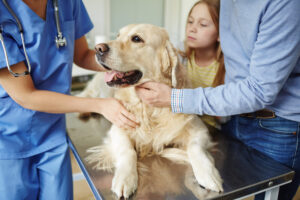In recent years, Australia has witnessed a notable increase in veterinary costs, according to PetSure, Australia’s leading pet insurance administrator.
From the increased cost of diagnostic testing to medical and technological advancements to the rapid aging of pets, there are many factors that may influence higher pet healthcare costs and the exceptional value of veterinary care provided by veterinarians.
Rapid ageing of pets
Pets age at a more rapid rate than humans – PetSure analysis shows one human year is equivalent to around 5.3 dog years. The accelerated rate at which pets age increases the likelihood that the pet will need veterinary care.
While pets experience accidents and illness at every age, older pets are more likely to experience more health conditions like arthritis and cancer, and this increased risk comes at an additional cost.
Increased Cost and Uptake of Diagnostic Testing
Diagnostic testing plays a crucial role in identifying and treating animal diseases effectively, and PetSure has observed an increase in both frequency and cost of diagnostic testing, such as blood tests. With an increased frequency of approximately 14% year on year (YoY) from 2022-2023*, this increased uptake of blood tests in pets may be attributed to its role in early detection of health issues and comprehensive assessment, which may be due to the heightened awareness about preventive care.
Technological Advancements
The rapidly evolving landscape of medicine, surgery and diagnostic techniques in the human healthcare industry is mirrored in the veterinary industry. These technological improvements like MRIs and CT scans enhance the quality and sophistication of pet patient care, therefore contributing to rising costs. Cutting-edge equipment, specialised training for veterinary professionals, and ongoing maintenance expenses all add up. These advancements streamline procedures and tests, improve accuracy and efficiency in diagnosis and treatment, which are embraced by pet parents and veterinary industry professionals alike.
Limited Government Funding
Veterinarians have ethical obligations as well as public expectations placed on them to provide care for little or no payment – a topic that was discussed in the recent hearing for the government inquiry into the NSW veterinary workforce shortage. Limited public funding allocations for animal care, such as wildlife rehabilitation, biosecurity, disease surveillance, and stray animal care further strain veterinary resources. This can cause an indirect rise in costs as veterinarians attempt to provide care for a larger number of animals with limited resources.
Increased Registration Fees
The veterinary industry in Australia operates under strict regulation. All practicing veterinarians must be registered with state or territory boards, which oversee complaint investigation, disciplinary procedures, and issue guidelines. Initial registration mandates that a practising vet must obtain a Bachelor of Veterinary Science or Doctor of Veterinary Medicine, with requires ongoing annual registration and continued education for eligibility – both of which come at a cost.
Registration fees differ depending on the board, state and whether the veterinarian is a general or specialist. For example, the cost to register with the Veterinary Practitioners Board in VIC the general renewal fee is $489 while the specialist renewal fee is $815.
Regulations are intended to safeguard public and animal welfare, through maintaining professional standards and ensuring the quality of veterinary care. But it does come at a cost for vets. As these fees rise, the cost may be passed onto consumers in the form of higher service charges.
The veterinary inflation cost in Australia is a multifaceted issue, influenced by technological advancements, limited government funding, and the rising cost of diagnostic testing among other factors.
While increased costs impact pet parents, veterinarians and those in the wider animal welfare community, these costs reflect the higher standard of care at which Australian veterinarians operate. As the landscape continues to evolve, stakeholders must work collaboratively to strike a balance between technological progress, accessible care, and responsible funding to ensure the health and wellbeing of Australia’s pets.
References:
*PetSure claims data, year-on-year increases comparing claims paid in May – July 2022 compared to May – July 2023.
- https://www.ava.com.au/globalassets/authors/ava_submission_proposed-changes-to-vet-board-regulatory-fees-2023-24-final.pdf
- https://www.ava.com.au/policy-advocacy/policies/professional-practices-for-veterinarians/unpaid-veterinary-services-performed-for-public-good/Unpaid veterinary services performed for public good
- https://consultations.tga.gov.au/regulatory-practice-section/public-consultation-tga-fees-and-charges-proposal/user_uploads/pta-2023-24-consultation-response—tga-fees-and-charges-proposal.pdf
- abc.net.au/news/foetal-calf-blood-record-price-vital-for-cancer-research/102780202
- Consumer Price Index, Australia Latest release
The Consumer Price Index (CPI) measures household inflation and includes statistics about price change for categories of household expenditure. Reference period
June Quarter 2023 https://www.abs.gov.au/statistics/economy/price-indexes-and-inflation/consumer-price-index-australia/latest-release
Pet insurance can help by covering a portion of the eligible vet bill if the unexpected happens. Because it is difficult to predict the costs of veterinary care, it can help to have measures in place to help prepare for the unexpected. Check out our partner network and explore our policy tools to find a pet insurance policy.
Not all conditions or items are covered by Pet Insurance. Refer to the applicable Product Disclosure Statement for information about coverage and exclusions.








